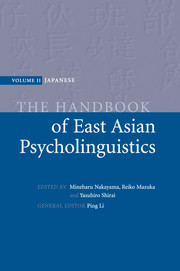Book contents
- Frontmatter
- Contents
- List of figures
- List of contributors
- In memory of Miwa Nishimura
- Preface
- Introduction
- Language acquisition
- Part II Language processing
- 26 The phonetic and phonological organization of speech in Japanese
- 27 Speech segmentation by Japanese listeners: its language-specificity and language-universality
- 28 Prosody in sentence processing
- 29 Speech errors
- 30 Effects of word properties on Japanese sentence processing
- 31 Orthographic processing
- 32 Lexical access
- 33 Incrementality in Japanese sentence processing
- 34 Processing alternative word orders in Japanese
- 35 Processing relative clauses in Japanese: coping with multiple ambiguities
- 36 Processing empty categories in Japanese
- 37 The difficulty of certain sentence constructions in comprehension
- 38 Reading and working memory
- 39 Sentence production in Japanese
- 40 The neural basis of syntactic processing in Japanese
- 41 The competition model
- 42 Connectionist models
- 43 Computational linguistics
- 44 Language and gesture as a single communicative system
- References
- Name index
- Subject index
28 - Prosody in sentence processing
from Part II - Language processing
Published online by Cambridge University Press: 05 June 2012
- Frontmatter
- Contents
- List of figures
- List of contributors
- In memory of Miwa Nishimura
- Preface
- Introduction
- Language acquisition
- Part II Language processing
- 26 The phonetic and phonological organization of speech in Japanese
- 27 Speech segmentation by Japanese listeners: its language-specificity and language-universality
- 28 Prosody in sentence processing
- 29 Speech errors
- 30 Effects of word properties on Japanese sentence processing
- 31 Orthographic processing
- 32 Lexical access
- 33 Incrementality in Japanese sentence processing
- 34 Processing alternative word orders in Japanese
- 35 Processing relative clauses in Japanese: coping with multiple ambiguities
- 36 Processing empty categories in Japanese
- 37 The difficulty of certain sentence constructions in comprehension
- 38 Reading and working memory
- 39 Sentence production in Japanese
- 40 The neural basis of syntactic processing in Japanese
- 41 The competition model
- 42 Connectionist models
- 43 Computational linguistics
- 44 Language and gesture as a single communicative system
- References
- Name index
- Subject index
Summary
Introduction
The prosodic structure and accompanying intonational “melody” of an utterance can provide a rich source of information to the sentence-processing mechanism. In spoken language, speakers mark prominences and group words into prosodic constituents by varying the pitch, timing, and other aspects of the voice. The intonational contour resulting from these variations can provide listeners with cues to the syntactic structure, information structure, and a variety of other linguistic structures. Thus, a crucial part of our understanding of spoken-language processing is our understanding of prosody, and how this structure maps onto the linguistic structures that we parse.
This chapter introduces Standard (Tokyo) Japanese prosodic structure and intonation, and outlines one of the most recent descriptions of Japanese intonation, the Japanese ToBI system. Then, it summarizes the literature on the mapping between prosodic structure and syntactic structure including recent studies examining the role of prosody in Japanese sentence processing, even in silent reading.
Japanese prosodic structure and intonation
Japanese intonation has been described from a variety of theoretical perspectives, ranging from mathematical models employing a composite of superimposed curves (e.g. Fujisaki & Sudo, 1971; Venditti & van Santen, 2000) to phonological models employing abstract tonal targets or patterns (e.g. McCawley, 1968; Poser, 1984; Pierrehumbert & Beckman, 1988; Venditti, 1995). Here we will focus on the phonological model of Japanese intonation described by the Japanese ToBI labeling scheme, which is currently the most widely used approach in psycholinguistics and phonology.
- Type
- Chapter
- Information
- The Handbook of East Asian Psycholinguistics , pp. 208 - 217Publisher: Cambridge University PressPrint publication year: 2006
- 1
- Cited by



